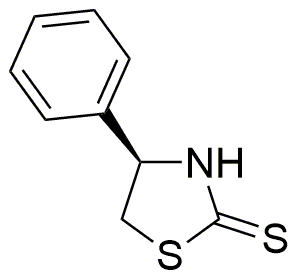(R)-4-Phenylthiazolidine-2-thione is widely utilized in research focused on:
- Pharmaceutical Development: This compound serves as a crucial intermediate in the synthesis of various pharmaceuticals, particularly in the development of drugs targeting metabolic disorders.
- Antioxidant Applications: It exhibits antioxidant properties, making it valuable in formulating products aimed at reducing oxidative stress in biological systems, which is beneficial for health supplements.
- Biochemical Research: Researchers use it to study enzyme inhibition and protein interactions, aiding in the understanding of various biochemical pathways.
- Agricultural Chemistry: This compound can be employed in developing agrochemicals, enhancing crop protection formulations against pests and diseases.
- Material Science: It is explored for its potential in creating novel materials with specific electronic or optical properties, contributing to advancements in nanotechnology.
General Information
Properties
Safety and Regulations
Applications
(R)-4-Phenylthiazolidine-2-thione is widely utilized in research focused on:
- Pharmaceutical Development: This compound serves as a crucial intermediate in the synthesis of various pharmaceuticals, particularly in the development of drugs targeting metabolic disorders.
- Antioxidant Applications: It exhibits antioxidant properties, making it valuable in formulating products aimed at reducing oxidative stress in biological systems, which is beneficial for health supplements.
- Biochemical Research: Researchers use it to study enzyme inhibition and protein interactions, aiding in the understanding of various biochemical pathways.
- Agricultural Chemistry: This compound can be employed in developing agrochemicals, enhancing crop protection formulations against pests and diseases.
- Material Science: It is explored for its potential in creating novel materials with specific electronic or optical properties, contributing to advancements in nanotechnology.
Documents
Safety Data Sheets (SDS)
The SDS provides comprehensive safety information on handling, storage, and disposal of the product.
Product Specification (PS)
The PS provides a comprehensive breakdown of the product’s properties, including chemical composition, physical state, purity, and storage requirements. It also details acceptable quality ranges and the product's intended applications.
Certificates of Analysis (COA)
Search for Certificates of Analysis (COA) by entering the products Lot Number. Lot and Batch Numbers can be found on a product’s label following the words ‘Lot’ or ‘Batch’.
Numéro de catalogue
Numéro de lot/série
Certificates Of Origin (COO)
This COO confirms the country where the product was manufactured, and also details the materials and components used in it and whether it is derived from natural, synthetic, or other specific sources. This certificate may be required for customs, trade, and regulatory compliance.
Numéro de catalogue
Numéro de lot/série
Safety Data Sheets (SDS)
The SDS provides comprehensive safety information on handling, storage, and disposal of the product.
DownloadProduct Specification (PS)
The PS provides a comprehensive breakdown of the product’s properties, including chemical composition, physical state, purity, and storage requirements. It also details acceptable quality ranges and the product's intended applications.
DownloadCertificates of Analysis (COA)
Search for Certificates of Analysis (COA) by entering the products Lot Number. Lot and Batch Numbers can be found on a product’s label following the words ‘Lot’ or ‘Batch’.
Numéro de catalogue
Numéro de lot/série
Certificates Of Origin (COO)
This COO confirms the country where the product was manufactured, and also details the materials and components used in it and whether it is derived from natural, synthetic, or other specific sources. This certificate may be required for customs, trade, and regulatory compliance.


